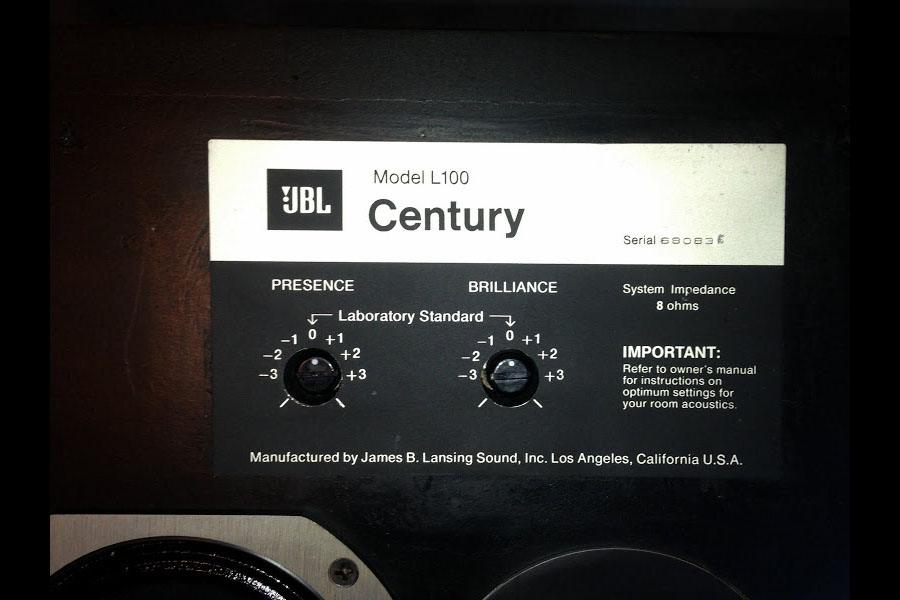Tech Talk
The JBL L100 – Similarities and Differences Between the New Classic and the Century
By Chris Hagen, Principal System Engineer
As we get ready to celebrate our 75th anniversary and offer a limited production of the L100 Class 75, we thought it would be interesting to go back to the original L100 to see what has changed.

When HARMAN first released the JBL L100 Classic, there was a great amount of excitement and interest all the way from product development through to the end user. Since we were naming it after the original L100 Century, there were key visual characteristics that had to be preserved. We quickly learned that we matched the look of the old model so well that not only were improvements not noticed, but even performance traits were confused between the two.
In fact, the L100 Classic has a walnut-veneered cabinet with a light satin finish, a grille frame with the same walnut edge-binding, and a black, burnt orange, or blue Quadrex grille so the outer look of the L100 Classic is almost identical to the L100 Century. Admittedly, the L100 Century dark grille was dark brown and not black, but the L100 Classic black is close enough to look the same in pictures. Although the look of the walnut is not exactly the same due to lost data with time and different suppliers, the L100 Classic still has a fine period finish.
Further similarities are a 12-inch 3-way configuration, a ported alignment, and a single input terminal pair on the rear. Even before any L100 Classics arrived from the first build, internet posts claimed that they had “heard it before.” The L100 Classic received comments that clearly described the L100 Century: “Better with rock music,” and other comments about imaging. In order to clarify the differences, let’s take a look at the L100 Classic and the L100 Century and see what changed to improve the design.
Cabinet
Although it has been a while since we made the L100 Century, we followed a “lessons learned approach.” One way is the coloring of the grille. The L100 Century grilles were painted – leaving solvent on the foam – but the L100 Classic grilles are dyed for much greater longevity than the original. Also, the painted baffle and back of the L100 Century cabinet was frequently non-uniform in coverage with light areas. So we used a material that is always uniform in color and finish – a subtle, pebble finish vinyl veneer. Because the original L100 had split plastic grille pegs, we opted for the more modern plastic ball grille attachment. This ball attachment is cleverly used with slots instead of cups to allow the end user to align the grille when they reattach it, while still providing a positive hold of the grille.
Other more generalized improvements were added, such as changing out the nickel-plated spring-loaded terminals for larger, stronger gold-plated binding-post-style terminals; thickening the baffle from ¾-inch in the original to 1-inch in the L100 Classic; and adding a v-brace similar to the 4367 brace to the L100 Classic, both enhancing the rigidity of the cabinet. Because of our intent to improve the model, we also took the original L100 Century port – a 2-inch (L100) or 2.875-inch (L100A) sharp-edged tube – out and put in a 3-5/8-inch dual-flared port for much lower port noise.
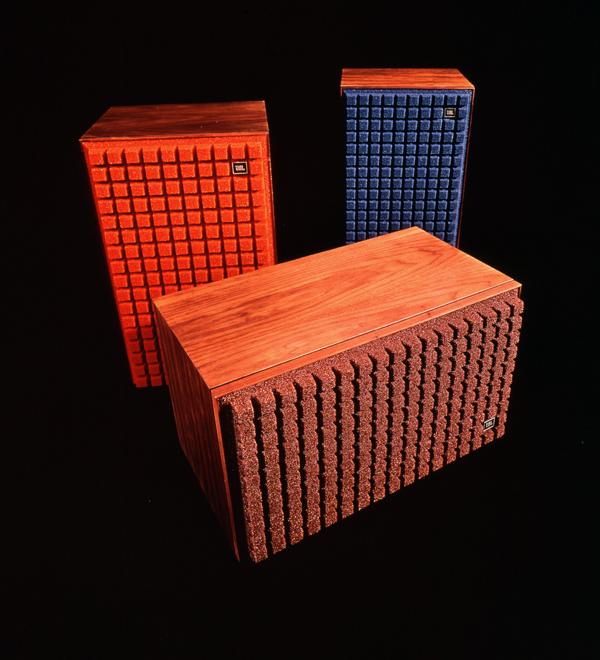
JBL L100 CENTURY
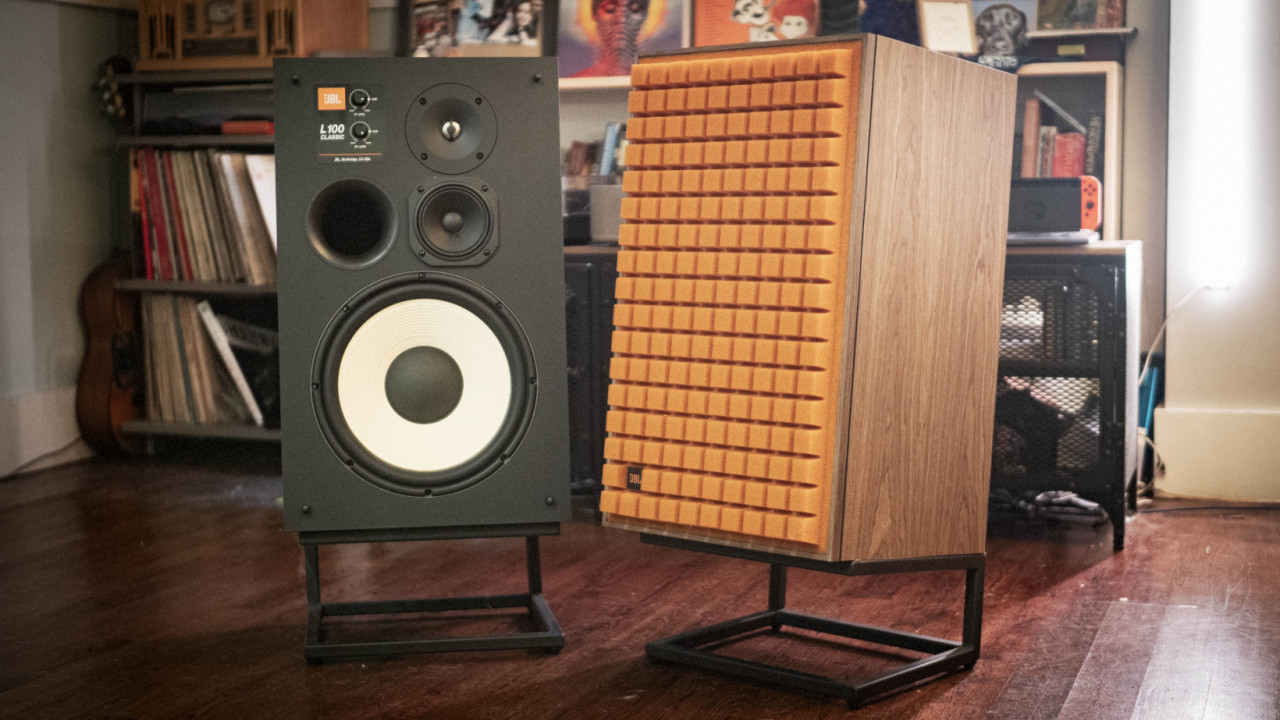
JBL L100 CLASSIC
The woofers of the old and new models are fairly different. Both the 123A-1 (or 123A-3 for the L100A) of the L100 Century and the JW300PW-8 of the L100 Classic are white-coned, 12-inch cast-frame woofers with 3-inch voice coils, but those are the only similarities. However, the old cone was a paper cone with Aquaplas added, whereas the new cone is of our modern Pure Pulp material and needs no Aquaplas. The L100 Century’s woofer, the 123A-1 for early models and the 123A-3 for late “A” models, had an Alnico magnet-based motor that weighed about 8 pounds less than the newer, magnetic-FMEA-optimized, Ferrite-magnet-with-SFG-based motor of the L100 Classic’s JW300PW-8. The new optimized motor structure results in lower distortion over larger voice coil movements. This larger excursion is supported by use of a half-forward-roll rubber surround on the new woofer, whereas the cloth accordion roll of the L100 Century woofer is less appropriate for large excursions needed by loud low-bass frequencies.
The midranges of the two L100s – the 105H-1 of the L100 Classic and the LE5-2 of the L100 Century – are very similar; both about 5-inch in size, with curvilinear cones and cloth accordion surrounds. However, the L100 Classic midrange has a larger voice coil for improved power handling and the motor has been optimized with modern FMEA programs for more efficient, linear operation and lower distortion. The 105H-1 cone has also been replaced with a modern polymer-coated Pure Pulp cone for greater rigidity and more controlled high-frequency performance.
The tweeter experienced the largest upgrade of the drivers, since several of the components of the L100 Classic tweeter did not exist in the L100 Century’s era. Oddly enough, we noticed that many commenters on the internet had forgotten that the L100 Century always had a cone tweeter. The early L100 Century’s used a 1.8-inch diameter paper cone tweeter – the LE-25, and the L100A (later Century model) used a 1.4-inch cone tweeter, the LE-20. The new L100 Classic employs a much more modern 1-inch titanium dome tweeter (JT025TI1-4) mated to a soft surround. The titanium gives excellent rigidity to the dome, while the smaller dome has wider dispersion. Since the L100 Century tweeters both had 5/8-inch voice coils, and the L100 Classic’s tweeter has a large motor structure with ferrofluid around the voice coil to absorb heat, the L100 Classic tweeter handles more power.

Crossover
The crossover was another area with a large amount of change, but most resulted from an update in design approach.
The L100 Century was designed at a time when the on-axis measurement was the only frequency response measurement considered. It was also designed around a 12-inch woofer with a smooth response up to about 2.5 kHz or so. Fundamental to the crossover design was to use no crossover on the woofer and minimal crossover on the midrange and tweeter, so, other than the pair of l-pads, there was only an 8 uF capacitor on the midrange and a 3 uF capacitor on the tweeter. This allowed the midrange to run freely to its maximum frequency, just like the woofer. The crossover frequencies were 1.5 kHz and 6 kHz with a lot of overlap between each driver’s contribution and the next.
Although this type of design can lead to a popular speaker, the use of drivers high into the range where their dispersion narrows with excessive overlap can create a system with poor off-axis response. This, along with having multiple sources trying to produce the same frequency can cloud detail that helps make a convincing image. The L100 Century also was largely sold as the L100A in non-mirror-imaged pairs, with the woofer and tweeter on the same vertical axis but the midrange offset about 4 inches from this center line. This further damaged the L100 Century’s imaging by shifting the various frequency sources. Also, use of first-order crossovers like in the L100 Century lowered the system power handling to 50W because the drivers are not as protected from damaging low frequencies. At the time of its production, though, the power handling was enough and the imaging was the equal of any speaker available.
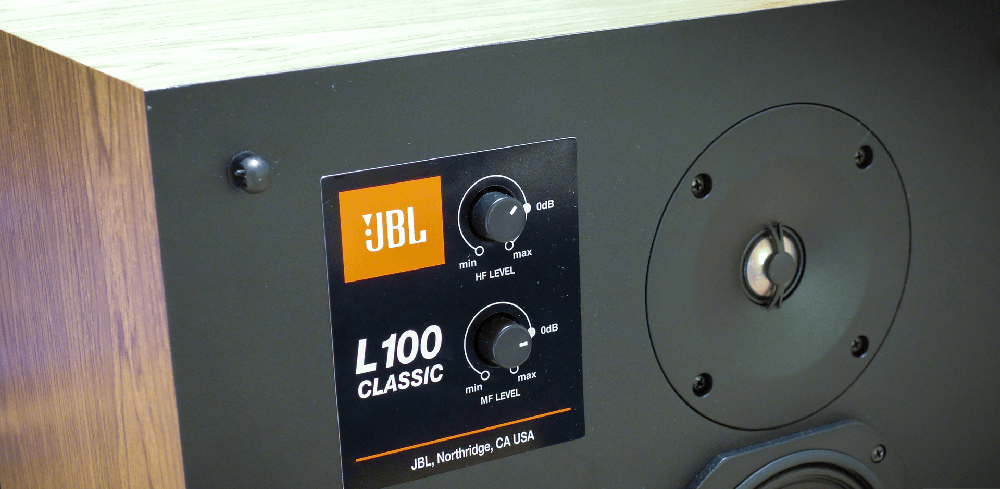
The modern L100 Classic crossover was designed with the off-axis energy in mind due to our advancements in understanding of the room-speaker acoustical interaction. The drivers were blended with low crossover frequencies for a smooth soundpower measurement, with positive summation at all points. Higher-order crossover slopes were also used for a smooth spin, and minimal adjustment filters such as notches were used. In comparison, the L100 Century’s pair of 1st-order high pass filters were upgraded to a 2nd-order low-pass on the woofer, a 2nd-order high-pass and 2nd-order low-pass on the midrange, and a 3rd-order high-pass on the tweeter. With additional components to limit the amount of cut of the l-pads – giving finer control of the mid-frequency and high-frequency levels – the total L100 Classic crossover parts count comes to 15 components (ignoring l-pads) compared to the L100 Century’s 2 components. All of these parts and higher order slopes, along with the latest drivers, raise the power handling of the L100 Classic to 200W, 4 times that of the L100 Century. Sensitivity stayed about the same at 90 – 91 dB/W/m, but nominal impedance dropped from 8 Ohm for the Century to 4 Ohm for the Classic. Consequently, the Classic will play a bit louder than the Century.
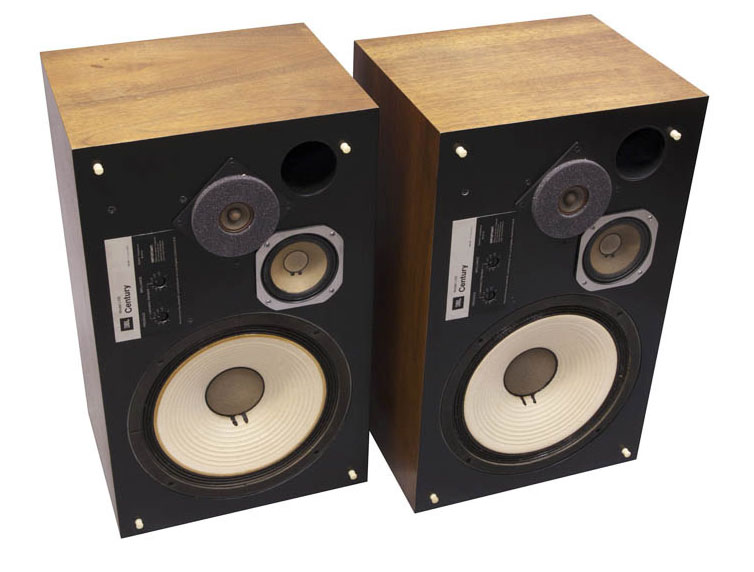
DRIVER CONFIGURATIONS FOR THE JBL L100 CENTURY (LEFT) AND L100 CLASSIC (RIGHT)

The last area of difference involves the cabinet size, midrange/tweeter offset, and crossover frequencies. At inception, we wanted the L100 Classic to be the same size as the Century, but have what is now recognized as the “correct layout” – the midrange and tweeter on the same vertical axis, preferably with the woofer, too. We also wanted to use a dome tweeter with a large motor structure to absorb heat and have low resonance, which meant that its faceplate would be large as well. This would increase the cabinet height by too much, so we decided to increase the cabinet slightly and offset the midrange and tweeter to the right by 2 inches (keeping the label to the left, like on the Century). This only increased the cabinet height by 1-1/2 inches and width and depth by 1 inch (for the same scaling in all directions), but allowed us to have the midrange-tweeter vertical array. But, should we mirror-image? This question was quickly answered by the soundpower-driven crossover. The final crossover frequencies for the L100 Classic were 450 Hz and 3 kHz. So the important question was “Is a 2-inch offset significant at 450 Hz?” At 450 Hz, the wavelength is 30 inches, so the offset is 1/15th of a wavelength. Human ears are fairly remarkable, but typically fine detail is resolved by a matter of local comparison. We thought that this 1/15th wavelength offset would not be an issue and then listened.
Conclusion
What we heard was a speaker with a very full bandwidth, with in-room audible response from 30 Hz to greater than 20 kHz, a very smooth but lively character, but a surprisingly 3-dimensional sonic image. We frequently found that the music seemed to be coming from invisible performers and the speakers were merely furniture in the room with no direct connection. Gross sound character was similar to the L100 Century, if you ignored the tight, full bass, the smoother mids, and the effortless and detailed highs, along with the vastly improved imaging.
It was at this point that we realized that we didn’t need to mirror-image the L100 Classic.
We were happy that we would not just be re-issuing the L100 Century with all its quirks, but a reborn L100 Classic that touched on key original L100 details but with much greater performance that could go head-to-head with much more expensive speakers. This also made the addition of 16 lbs. to the L100 Century’s 42-1/2 lbs. all that easier to accept!

